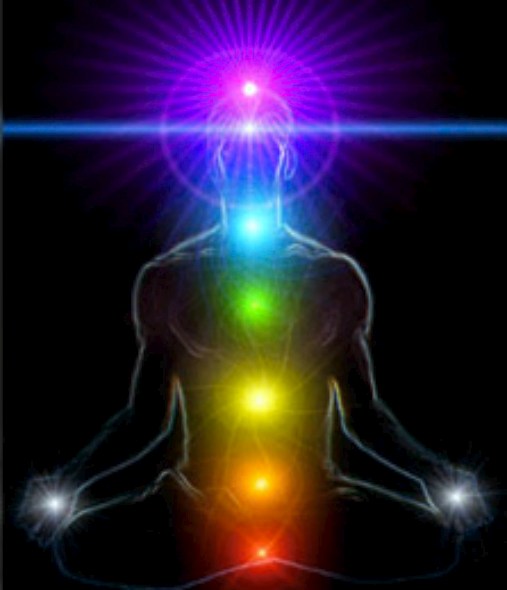Introducing the Human Chakra/Energy System
Chakra is a concept that originated from ancient Hindu texts, and was also featured in the yogic traditions of Hinduism and Buddhism. The word Chakra is an ancient Sanskrit term, that means "wheel" or "turning".
Chakras are theoretical wheel-like energy vortexes which, according to traditional Indian medicine, are believed to exist inside the etheric portion of the human body, kind of like a copy of the physical human body completely comprised of energy. The Chakras are said to be "force centers" or whorls of energy that act as the focal point for the reception and transmission of consciousness. There are many systems for viewing the Chakras, some representing the human body having up to 40,000 of them. The system I'll be focusing on in this post is the one most popular in Western culture, having only 7 main Chakras that run along the length of the spinal column.
It is believed that we have seven main Chakra centers and that each main center is connected to our being on several different levels: physical, emotional, mental and spiritual. On the physical level each Chakra governs a main organ or gland, which is then connected to other body parts that resonate at the same frequency.
Every organ, gland and body system is connected to a Chakra and each Chakra is connected to a color vibrational frequency. For example, the heart Chakra governs the thymus gland and it is also in charge of the functioning of the heart organ, lungs, bronchial system, lymph glands, secondary circulatory system, immune system as well as the arm and hands. The heart Chakra resonates to the color green.
The seven main Chakra centers are aligned along the spinal column. If there are disturbances on any level, this shows in the chakra’s vitality level. Also each of the seven main Chakras is their own intelligence center. This means that each chakra is not only associated with our physical health but also controls aspects connected to our emotional, mental and belief systems.
Provided below is a brief description of each Chakra along with guided meditation exercises pertaining to each one. I recommend starting with the Root (Muladhara) Chakra first, then work your way up. It's quite the experience!

Chakra Seven: Sahasrara (Crown)
Thought, Universal identity, oriented to self-knowledgeThis is the Crown Chakra that relates to consciousness as pure awareness. It is our connection to the greater world beyond, to a timeless, space-less place of all-knowing. When developed, this Chakra brings us knowledge, wisdom, understanding, spiritual connection, and bliss.
Chakra Six: Ajna (Third Eye)
Light, Archetypal identity, oriented to self-reflection. This Chakra is known as the Brow Chakra or third eye center. It is related to the act of seeing, both physically and intuitively. As such it opens our psychic faculties and our understanding of archetypal levels. When healthy it allows us to see clearly, in effect, letting us “see the big picture.”
Chakra Five: Vishuddha (Throat)
Chakra Five: Vishuddha (Throat)
Sound, Creative identity, oriented to self-expression. This is the Chakra located in the throat and is thus related to communication and creativity. Here we experience the world symbolically through vibration, such as the vibration of sound representing language.
Chakra Four: Anahata (Heart)
Air, Social identity, oriented to self-acceptance. This Chakra is called the heart chakra and is the middle Chakra in a system of seven. It is related to love and is the integrator of opposites in the psyche: mind and body, male and female, persona and shadow, ego and unity. A healthy fourth Chakra allows us to love deeply, feel compassion, have a deep sense of peace and centeredness.
Chakra Three: Manipura (Solar Plexus)
Chakra Three: Manipura (Solar Plexus)
Fire, Ego identity, oriented to self-definition. This Chakra is known as the power chakra, located in the solar plexus. It rules our personal power, will, and autonomy, as well as our metabolism. When healthy, this Chakra brings us energy, effectiveness, spontaneity, and non-dominating power.
Chakra Two: Svadhisthana (Sacral)
Water, Emotional identity, oriented to self-gratificationThe second Chakra, located in the abdomen, lower back, and sexual organs, is related to the element water, and to emotions and sexuality. It connects us to others through feeling, desire, sensation, and movement. Ideally this chakra brings us fluidity and grace, depth of feeling, sexual fulfillment, and the ability to accept change.
Chakra One: Muladhara (Root)
Earth, Physical identity, oriented to self-preservationLocated at the base of the spine, this Chakra forms our foundation. It represents the element earth, and is therefore related to our survival instincts, and to our sense of grounding and connection to our bodies and the physical plane. Ideally this Chakra brings us health, prosperity, security, and dynamic presence.
Whether you consider the Chakra system to be a part of our reality, or just fictional metaphysics, the fact remains that using this system as a psychological tool can be of much benefit to your overall personal growth. I highly recommend studying this fascinating concept because it can empower your life tremendously as it has my own.
Credit for the videos go to their creator, AstralShayde
























3 comments
Comment by Anonymous on October 17, 2011 at 12:37 AM
This is a very useful and comprehensive guide. I will be studying this carefully. Thank you so much for sharing this information Sapientia.
Comment by ScrewsAndFeathers on October 17, 2011 at 3:33 AM
I consider the chakra-theory an interesting metaphysical concept, yes.
Comment by Kyle Maine on October 17, 2011 at 11:24 PM
This is definitely an interesting read. Love this kind of abstract thinking.